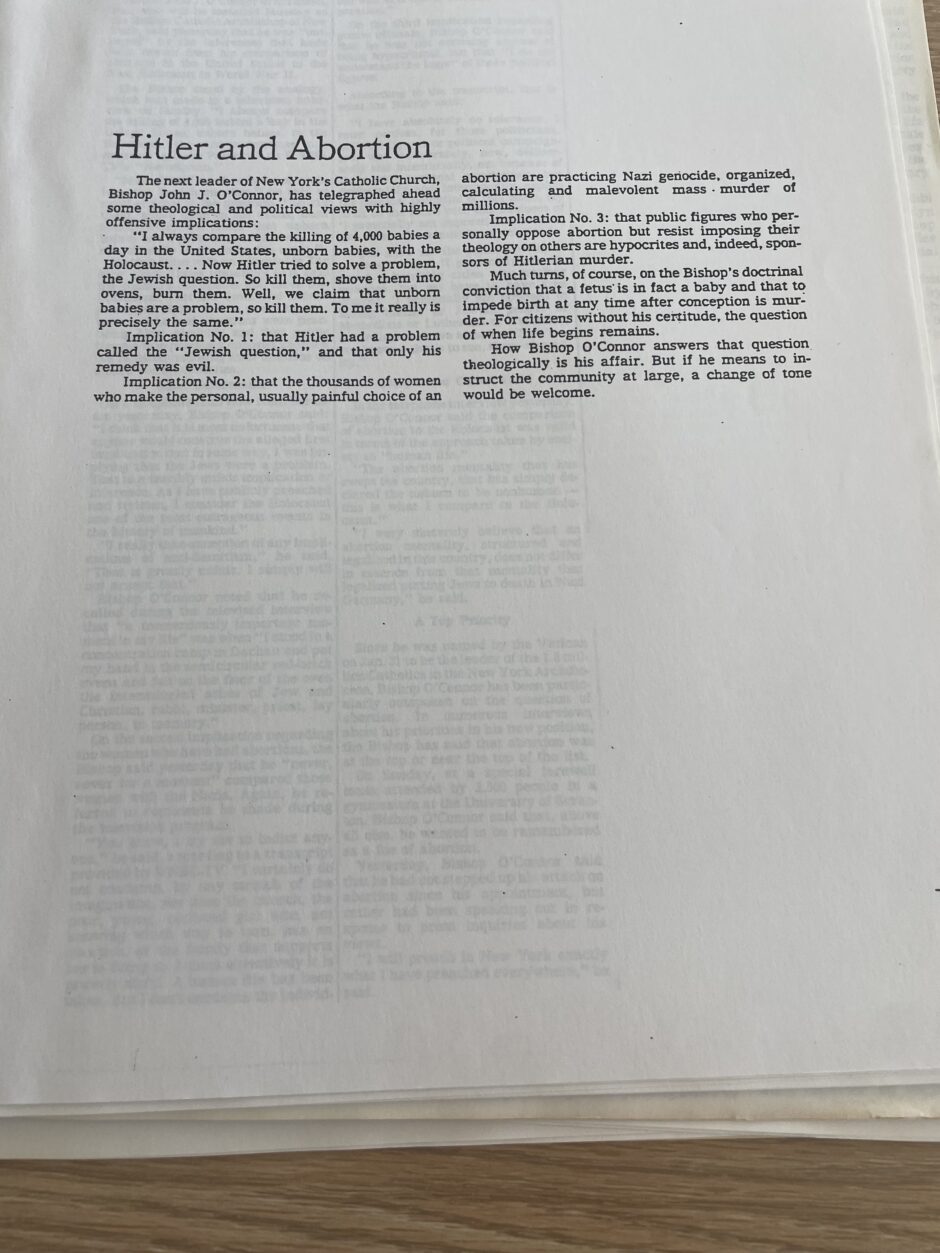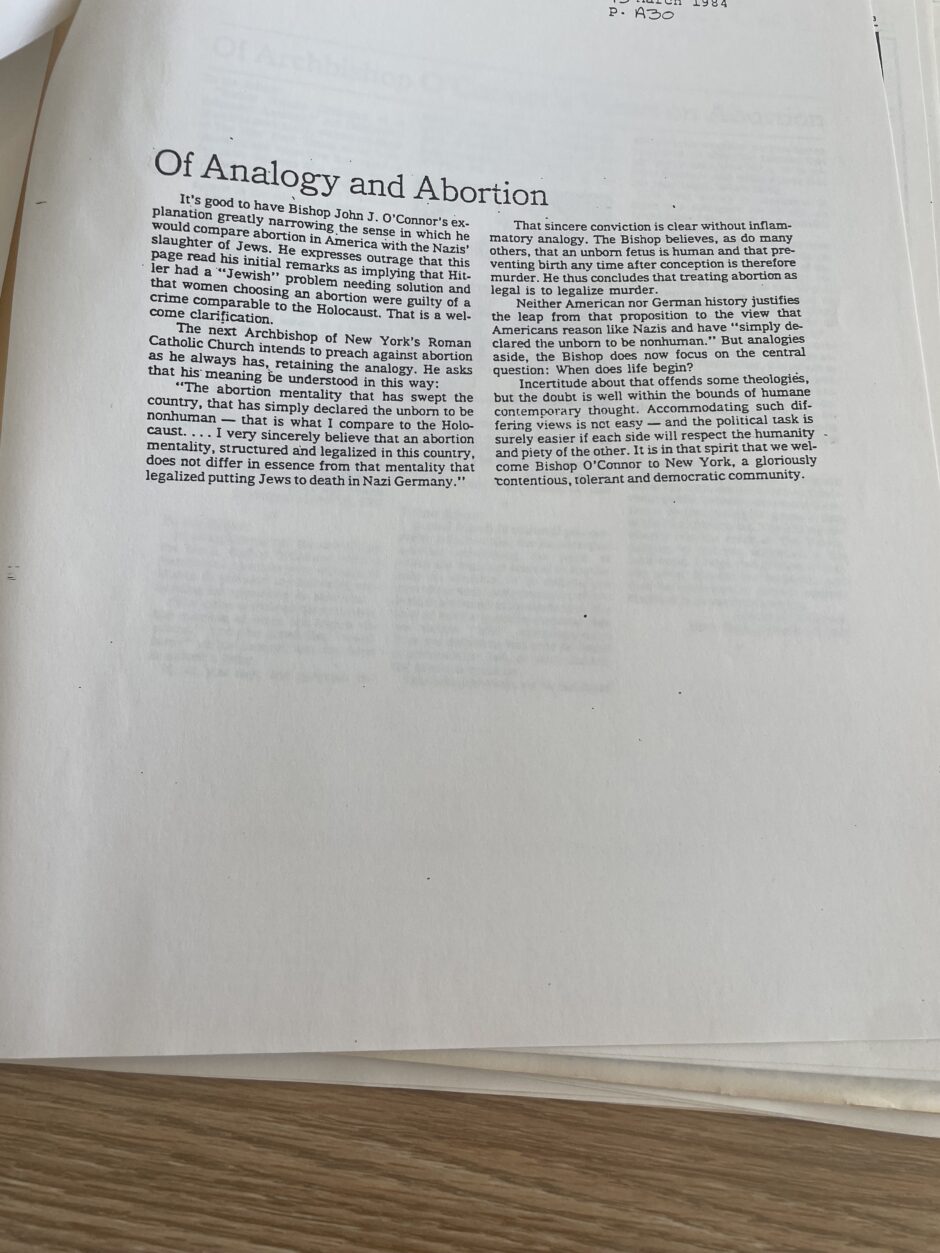Summary
Common Ground and Asking Questions is a personalized journey of understanding both sides of the abortion discussion, forming opinions, and trying to find a middle ground between the current pro-life and pro-choice movements. This podcast is created around an interview I conducted with President of the Massachusetts Citizens for Life Organization, Myrna Maloney Flynn. My curiosity of the pro-life group and wanting to learn their perspective directly from them is a very important part of the podcast. The podcast will draw from Flynn’s answers to questions and what sparked my personal curiosity. Ultimately, the podcast will try to highlight the importance of curiosity, asking questions, and education as a way to formulate your own opinions, specifically around the pro-life and pro-choice argument in our current world. Ultimately, the podcast will leave the reader with a few ideas of what a possible middle ground for this debate could be and if there is a way to get there.
By Lindsay Bennett
Transcript
*Opening music with voiceover*
Lindsay Bennett: Hello and welcome to Common Ground and Asking Questions, a Podcast that tracks the pro-life movement from its origins to today and discusses the importance of educating yourself.
*music*
Lindsay Bennett: My name is Lindsay Bennett and I will be talking you through my personal exploration of looking into the pro-life perspective.
*music*
Lindsay Bennett: Personally, I felt as though my education on reproductive rights and abortion was one sided and told from the perspective of those who aligned with pro-choice morals. I became curious to answer three questions for myself. The first being, If I looked into the pro-life stance, would it change my opinion as a pro-choice person? The second, is there a middle ground that the two movements can reach? And finally, can looking into reproductive rights through a pro-life lens help to offer solutions or provide actionable steps for the pro-choice movement?
*music*
Lindsay Bennett: I first began my research in the archives of Smith College in the Sophia Smith Collection where I found an article published by the New York Times on March 14th, 1984 that was titled “Bishop Rebuts Criticism Of a Holocaust Analogy.” This article includes quotes from Bishop John J. O’Connor of Scranton, Pennsylvania who was installed as the Roman Catholic Archbishop of New York.1 The title caught my eye and as I began to read, it became clear to me that I did not understand the pro-life side. Bishop O’Connor said “I very sincerely believe that an abortion mentality, structured and legalized in this country, does not differ in essence from that mentality that legalized putting Jews to death in Nazi Germany.”2
Lindsay Bennett: While this was just one source from 1984, I wondered if this was a case specific mindset or if the opinions of the Bishop were common in the pro-life movement in the 1980s and today.
Lindsay Bennett: Upon doing further research in encyclopedias, I began to see the recurring pro-life tendency to compare abortion to major horrific events such as the holocaust and slavery.
Lindsay Bennett: I then reached out to the Massachusetts Citizens for Life organization and interviewed President Myrna Maloney Flynn. Conducting this interview along with additional research, I was able to see how the movement has developed over time.
Lindsay Bennett: The most significant theme that I saw was the severity of abortion in the minds of pro-life individuals. In 1984, Bishop O’Connor compared abortion to the holocaust, in 2008 in reference to Roe V. Wade, Dorothy E. McBride said that, “the last time the Court tried something like this in the name of individual rights was when it said slavery was okay because people had a right to own slaves and do what they wanted.”3
And finally, Myrna Flynn said:
Myrna Malonely Flynn: You know, look, we, we, we don’t have a clean comparison to slavery. But, we can look back now and and I think pretty universally here in America, we would all agree that it was egregious and horrific and wrong, and it treated a whole class of people, a whole class of human beings, as less than human, and we were wrong to do it. And I think we will get to a point we know we will, where people will wake up and start to recognize the absolute atrocity that’s happening 1000s of times a day on the most absolute, innocent, vulnerable members of our human family.
*music*
Lindsay Bennett: The next major theme I identified was that the care for a woman’s life has always been a debate between the two sides. Pro-choice people depict pro-lifers as people who disregard the rights of women. However, the pro-life movement does value women and their health, just in a different way. To them, supporting women means preserving their dignity and providing resources to maintain their health and the health of the baby. Myrna Maloney Flynn highlights her concern for the dignity and care of women.
Myrna Maloney Flynn: The state of Massachusetts mandated public colleges and universities here to carry the abortion pill in their campus health offices. And so now, you know, girls on on college campuses like yourself can can go and grab the pill from their health office and go back to their dorm, into the dorm bathroom and, you know, flush a child down the toilet. You know, nobody has to know. Certainly, the parents have no idea. But there’s no one there to care for these girls. And it’s, it’s just mentally, physically, yeah, we have to do better, because that’s not honoring a woman’s dignity at all.
Lindsay Bennett: Both sides care about the health of women, but disagree on how to provide support.
*music*
Lindsay Bennett: Continuing with this theme of supporting the mother, the question of what it looks like to support the mother’s health is raised. Well, let’s see Myrna Flynn’s response to this question.
Myrna Maloney Flynn: We would absolutely support that exception to save a woman’s life. And yet, you know the actual reality is that a child never needs to die in order to save its mother’s life.
Lindsay Bennett: Myrna’s opinions generally support the pro-life movement’s stance over time. According to my research, there have been two stances on how to answer this question. The first being that there should be a total abortion ban, and the second being that there should be an abortion ban with the exception to permit abortions to save the life of the mother.4
*music*
Lindsay Bennett: Finally, and what I think is most important is the question of is there a middle ground that the two movements can reach? I decided to ask Myrna Maloney Flynn this question in my interview.
Myrna Maloney Flynn: I think that, you know, we would be thrilled if at some point in the very near future, we could at least limit the age at which abortions are performed. You know, in my mind, you know, 12 weeks would be wonderful.
*music*
Lindsay Bennett: After hearing all these connections, I want to revisit the three questions I posed at the beginning of this podcast.
Lindsay Bennett: My first question was if I looked into the pro-life stance, would it change my opinion as a pro-choice person. After conducting my research, my answer is that it did not change my alignment with the pro-choice movement, but it did help me to learn the pro-life stance and has helped me gain the skills to engage in conversation with those that I may not agree with.
Lindsay Bennett: The second question I asked was about finding a middle ground. This is now a question I pose to listeners, do you think there is a middle ground that we can reach as two separate movements? What is that middle ground and how do we get there? To answer this question myself, I think the common ground is the protection of women’s lives and mental health. There is still much work to be done around education and access to reproductive health and it seems as though both movements are attempting to do this in two separate ways.
Lindsay Bennett: And finally to conclude this podcast, can looking at reproductive and abortion history through a pro-life lens offer solutions or provide actionable steps for the pro-choice movement? I believe that understanding your opponent’s stance and educating yourself is a great first step to take and can inspire ideas of how to move forward. While I did not agree with everything Myrna Maloney Flynn said in the interview, the conversation did allow for me to hear a perspective I otherwise would have avoided.
*music*
Lindsay Bennett: Thank you so much for listening to this podcast. I encourage you to challenge yourself and have difficult conversations with those with differing perspectives and ensure that you have put in the work to educate yourself.
- Molly Yard papers, Sophia Smith Collection, SSC-MS-00469, Smith College Special Collections, Northampton, Mass. ↩︎
- Molly Yard papers, Sophia Smith Collection. ↩︎
- McBride, Dorothy E. 2008. Abortion in the United States. Santa Barbara, California: ABC-CLIO, Inc. ↩︎
- McBride. Abortion in the United States. ↩︎
References
Flynn, Myrna Maloney. 2024. Pro-life Information Interview by Lindsay Bennett. “Massachusetts Citizens for Life.” 2024. Massachusetts Citizens for Life. 2024. https://www.masscitizensforlife.org/.
McBride, Dorothy E. 2008. Abortion in the United States. Santa Barbara, California: ABC-CLIO, Inc.
Molly Yard papers, Sophia Smith Collection, SSC-MS-00469, Smith College Special Collections, Northampton, Mass.
Palmer, Louis J, and Xueyan Z Palmer. 2009. Encyclopedia of Abortion in the United States. Second. Jefferson, North Carolina: Mcfarland & Company, Inc., Publishers.
Shabad, Rebecca , Rose Horowitch, Zoë Richards, and Julia Jester. 2023. “Anti-Abortion Advocates Hold Annual March for Life Rally since Roe Reversal for First Time.” NBC News. January 20, 2023. https://www.nbcnews.com/politics/politics-news/march-life-anti-abortion-rally-set-take-place-first-time-roe-was-overt-rcna66514.



















